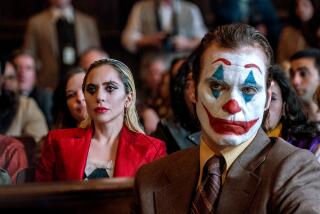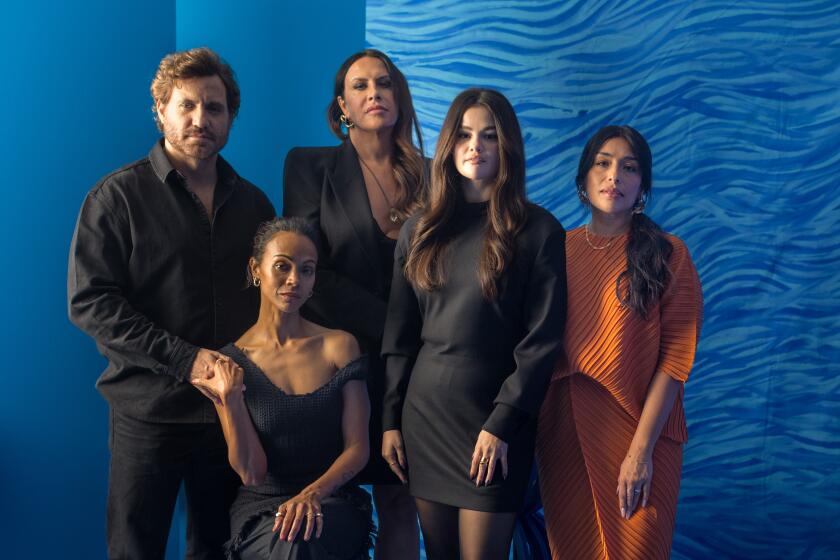From the Archives: In the ‘Star Wars’ saga, ‘Empire’ strikes forward
What can you say about “The Empire Strikes Back” that has not been said about the Acropolis, the cotton gin, Ella Fitzgerald’s voice and “Star Wars”?
That’s extravagant, of course, but the point is that there can have been very few sequels in history for which commercial and creative success could be so confidently predicted. The unprecedented attendance for “Star Wars” assures a lot of business, even with slippage. (You could argue that the spoilsports who resent all success would turn out in legions at the first whisper that “Empire” might not be up to the original).
In fact, “The Empire Strikes Back” seems to me a hugely accomplished and exciting follow-on to “Star Wars” — with a slow and extended stretch in the lategoing that will test the youngest and shortest attention spans, but with new material mixed with the familiar to rush the story forward.
It could hardly have been otherwise. The magic of “Star Wars” derived from George Lucas and his love of make-believe, at once childlike and hugely sophisticated, and from his myth-sized view of the absolutes of good and evil, courage and treachery. Lucas knows Once Upon a Time the way Hugh Hefner, in a remote part of the forest, knows bachelor dreams.
The extent of the popularity of “Star Wars,” and its games, toys and lunch pails, may have amazed even Lucas, but the creative integrity of the film was in no way accidental and the same sureness of vision (of the movies as well as of events in a galaxy far, far away) gives force to “The Empire Strikes Back.”
It is easier this time to sense the Grand Design. “Star Wars,” as is now known, was Episode IV of a nine-episode master plot Lucas has outlined. The first three stories are evidently prelude to “Star Wars,” and Episode IV was, Lucas felt, an easier and more dramatic place to start. “The Empire Strikes Back” is titled Episode V and indeed it feels much more like a segment in a larger story, with an ending which is (cleverly) both a resolution and a cliffhanger that leaves one of our heroes in chilling jeopardy and Darth Vader — ah, but that would be telling.
Sequels have costs and gains. A certain feeling of wondrous discovery is gone forever. After all, we’ve been to the galaxy before. On the other hand, the action can thrust forward, freed of a lot of expository needs, and with time to get a bit more deeply into characters and relationships, to embroider themes, to sketch more of that grander design and to invigorate the proceedings with new creatures and characters.
“The Empire Strikes Back” suggests strongly that the Lucas imagination has hardly begun to be tested. He and his scriptwriters, the late and excellent Leigh Brackett and her successor Lawrence Kasdan, have in particular come up with an absolute enchanter named Yoda, a wise old party who cannot be more than 2 feet high standing on tipclaw but who coached both Alec Guinness (Ben Kenobi) and Luke Skywalker’s father and is now trying to install some patient good sense into impetuous young Luke himself.
Yoda is operated by the same Frank Oz who is the wizard of Miss Piggy. Yoda is greenish, with a wispy tonsure and a deeply furrowed brow, hairy hands, a deep voice, unutterably sad and hooded eyes, a melancholy and comprehending smile and supernatural powers of mind over matter. He is a delicious invention and will be the best-selling doll next Christmas or I underestimate Lucas’ elfin sense of merchandising. His Yoda, a galactic gnome or maybe a light-year leprechaun, lives in a snaky and miasmal swamp but it doesn’t appear to bother him at all. It may even purify his mind for higher thoughts.
He touchingly tells Luke that the reason he keeps falling is that he doesn’t Believe. “Star Wars” and “The Empire Strikes Back,” like all superior fantasies, have the quality of parable, not only on good and evil but on attitudes toward life and personal deportment and there is something very like a moral imperative in the films’ view of hard work, determination, self-improvement, concentration and idealism. It does not take a savant to see that this uplifting tone only a little less than the plot and effects is a central ingredient of the wide outreach of the films.
Lucas & Company have this time created an ice planet, Hoth, where our rebel friends are hiding from the probing nastiness of the Emperor, his black-helmeted executive officer, Vader, and their lethal forces. Snow creatures which look part llama, part kangaroo, are the outdoor transportation and there is also a snow monster which nearly does in Skywalker, who is once again the youthfully innocent and engaging Mark Hamill.
(It is no small part of Lucas’ cinematic savvy that he understands that special effects, no matter how dazzling, cannot ever entirely replace the excitements of man-to-man or man-to-beast combat, or the tussle between man’s resources and nature’s ferocities. Some things don’t change, down the eons.)
Unquestionably the chanciest departure of “The Empire Strikes Back” is to advance the idea of a romantic triangle, with Carrie Fisher as the strong-willed princess sought after, in a teasing, robust way by Harrison Ford as Han Solo, but drawn to the handsome but reticent Luke. It is a construction that did wonders for Gable, Tracy and Loy among other classic screen trios and if it is kept light and urbane with the emphasis on palship and not on amorous sweats it should work nicely. Lucas I presume doesn’t need to be reminded that mushy stuff was a Saturday morning turn-off if there ever was one.
The rebels are found out and have to flee (superb action sequences, the Empire advancing with giant tanks built like elephants and needing to be lassoed like monumental steers). Guinness as Ben Kenobi makes a fleeting and ghostly appearance urging Luke to get to the swamp planet Dagobah and lessons with Yoda.
Aboard Solo’s Millennium Falcon, which seems to be the space equivalent of a ’58 Impala, our friends, including as before Chewbacca (Peter Mayhew), Artoo-Detoo (Kenny Baker) and See Three-pio (Anthony Daniels) escape through an asteroid storm (wow) and after intervening adventures drop in on a space outfit run by Billy Dee Williams as Lando Calrissian, one of Solo’s raffish old pals. There, we all may be sure, more adventures ensue, right up to a socko finish which leaves some long-term relationships unresolved.
Episode VI, Lucas says, will be called “Revenge of the Jedi.” It completes the middle trilogy of his remarkable saga and will also complete the struggle between Luke Skywalker and Darth Vader — winner to be announced later. Whether we’ll ever see Episodes I, II and III, involving Luke’s father, or Episodes VII, VIII and IX, which would carry the story forward another 20 years or so (the total span is 40), is not clear, What is certain is that the Lucas vision will be a part of our world for years.
Lucas was this time executive producer, with his longtime associate Gary Kurtz as line producer and Irvin Kershner as director. Kershner, whose previous credits include “Loving” and “A Man Called Horse,” but nothing in this line of work, proves to have been an unorthodox but good choice. The characters have been, as they say, fleshed out. Harrison Ford in particular has additional dimensions as, perhaps, a rascal at heart who finds himself captive of his own sense of duty and honor, an antihero grudgingly making do as a hero.
Carrie Fisher this time seems to have a newly steely turn of mind, a spirited independence. Hamill in these more rounded constructions is a man trying to grow, through moral choices and self-discipline.
You can’t help noticing that “The Empire Strikes Back” respects the truth that repetition and progress are different matters, and progress matters most.
The special effects, the work of a vast team (the credits list more than 250 individual names, plus several firms), are spectacular but there is somehow a subtle but notable difference between them and the rather self-conscious space epics we have seen since “Star Wars.”
In preparing “Star Wars,” Lucas talked about his concept of a used future (or a futuristic past) in which the gadgetries were seen to be not newfangled but well-worn. In that spirit, his special effects here, as mind-trying as they undoubtedly were to conceive and execute, seem in the best sense to be meant to be taken for granted, to excite no more comment than a saguaro cactus in the desert.
Naturally there are laser swords; you expected slingshots? Naturally a professional gambler like Calrissian, striking it rich, would design his planet to resemble the lobby of the newest biggest hotel in Las Vegas. Naturally things look and perform the way they look and perform.
What this is saying is, I suppose, simply that the effects work most marvelously well, as they do. It is just that the camera somehow does not genuflect before them; it uses them and it does make a difference.
The music as before is by John Williams and it is majestic and exciting, but, like the effects, it manages not to be overbearing or to draw unwarranted attention to itself.
It is manifestly impossible to cite even a fraction of the visual wizards at work on “The Empire Strikes Back,” led as they were by Lucas himself. But Norman Reynolds was the production designer, with Ralph McQuarrie as consultant. Peter Suschitzky was the cinematographer and Paul Hirsch the principal editor. Brian Johnson and Richard Edlund supervised the special effects. Stuart Freeborn oversaw the makeup and special creatures design, John Motto the costumes, Ben Burtt the remarkable sound. Harrison Ellenshaw supervised the matte painting and Dennis Muren did the effects photography.
“The Empire Strikes Back” is rated PG, I guess for the intensity of its excitements. But it is a family film or the term has lost its meaning altogether.
It is expansive but more tightly time-framed in terms of plot. I wish it were a handful of minutes shorter, but this is my single caveat about another richly imaginative, engrossing and spectacular motion picture from the redoubtable George Lucas.
It opens Wednesday at the Avco Westwood and Egyptian in Hollywood.
Back to the collection of reviews.
More to Read
Only good movies
Get the Indie Focus newsletter, Mark Olsen's weekly guide to the world of cinema.
You may occasionally receive promotional content from the Los Angeles Times.








